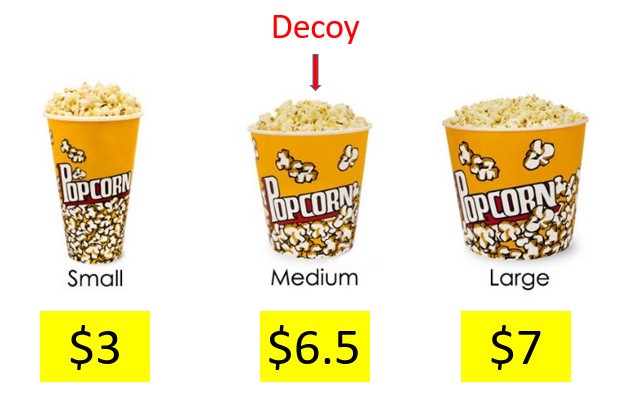
Similar to this, it’s not unusual to see a company or retailer sell a product just for the purpose of enhancing the appearance of another item or to rearrange the merchandise on their shelves so as to emphasise one item over another. For instance, the expensive iPhone 5s ($199) can make the more affordable iPhone 5c ($99) seem like a good deal. Alternatively, if the 5c were placed next to an older iPhone with fewer features, it may also seem like a wise investment. In both of these scenarios, the range of available products can significantly influence the decision a client makes.
How Decoys Work
Imagine that in addition to the iPhone 5s and 5c, Apple also introduced a new iPhone 5 model—name let’s it the 5x—that is exactly like the 5s in every manner (including cost) with the exception of a lower-quality camera. What impact will this have on users’ iPhone choices?
The first outcome is obvious: nobody will purchase the 5x because it is unquestionably inferior to the 5s. The second result may surprise you more: sales of the 5s will probably increase in comparison to the case where the 5x was never an option.
Itamar Simonson and Amos Tversky’s 1992 study examining the influence of the set of choices on decision itself is when the “Decoy Effect,” also known as asymmetric dominance, first took off in the behavioural economic field. The authors demonstrate (using film cameras rather than iPhone cameras) that adding an Option A- (the 5x) will make Option A more likely to be chosen if customers are torn between Option A and Option B (the 5s and 5c).
The Impact of Compromise
The “Compromise Effect,” another favourite finding in behavioural economics that Simonson and Tversky examine, also appears when customers are given three options. The psychology behind this effect is mainly that people either dislike or grow weary of mentally weighing different things against one another. It can be cognitively tiring to decide which features are crucial, how much they are worth, which product has the ideal combination, etc., therefore customers typically like to simplify the process as much as possible (sometimes consciously, and sometimes without realising it).
Managing choice sets is the Decoy Effect’s core principle.
The Decoy and Compromise Effects emphasise how crucial it is to consider all of the options you present to your customers. On the one hand, that calls for you to think about how customers will compare your products to one another and whether you already have any products that could serve as ruses or compromise solutions. On the other hand, it implies that you could wish to make some if you don’t already have any compromises or decoys.
Decoys are arguably simpler to make because all you need to do is provide a less appealing variation of an already available good or promotion. Contrary to the iPhone 5x example, it need not be identical to your target product, save for one flaw, but it must be immediately clear that it should be directly comparable. Also keep in mind that the decoy’s main purpose is to grab attention to your goods rather than just making it appear good. So if you remove a feature, increase the cost, or otherwise make it less appealing, you have a decoy!
Finding the product you want your clients to purchase and then making it appear to be a balanced alternative among your other products are necessary for creating a compromise option. It’s important to keep in mind that you may leverage the Compromise effect in two ways: by making your product an easy choice and a defensible choice. The greater the likelihood that your target product will be chosen, the simpler and more reasonable it appears in comparison to the alternatives!
Finally, it’s crucial to think about how many options you offer your clients. Having a lot of options, especially if the trade-offs between them are complicated, can discourage your clients because it is too difficult for them to choose the “best” option (although this is not always the case).
A tool for comparing products is one feature that would work well for this (and that I don’t believe I’ve ever seen before). Allow clients to simultaneously access details of two items from your inventory if they wish to directly compare them, but then add a third “suggested” item that acts as either a Deceiver or a Compromise.
Learnings on the Decoy Effect
Regardless of other possibilities, people are drawn to things that are obviously superior to one or more other options in their choice set (a “decoy”).
When a person is determined to acquire anything from a certain product category, they are especially drawn to things that are perceived as compromises between other possibilities.
Always keep in mind how crucial context is when someone is making a decision. You may significantly influence your clients’ decisions by using decoy products to make your target product appear superior or like the wisest choice.
